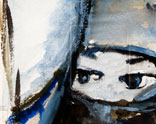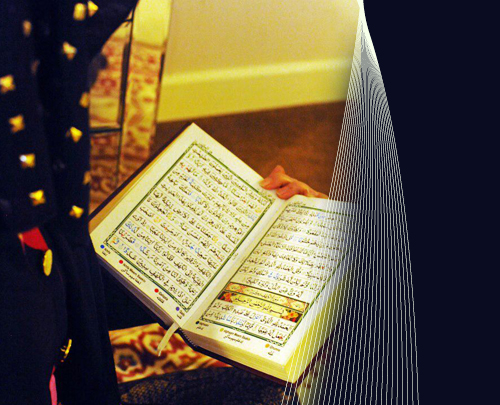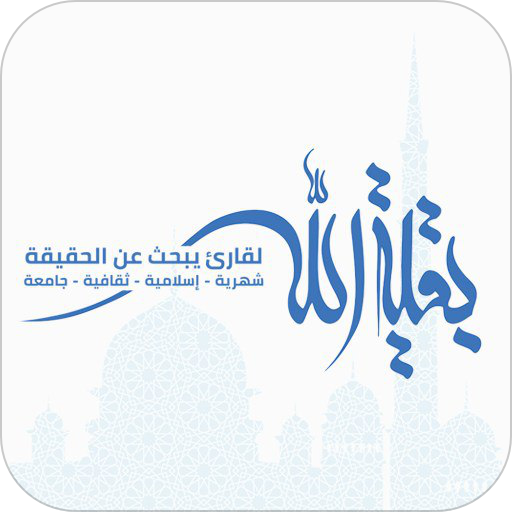The Veil
Introduction
The veil is one of the most important controversial issues in the societies on the general social level because of its great influence on the determination of the identity of the society and because of its basic and crucial role as regards the approach and the behavior of the society with both its men and women.
As a result, the veil is always exposed to campaigns of distortion and weakening by means of controversy and suspicion at one time; by means of the practical confrontation through the laws of restriction and forbiddance at another time; and by means of attempting, through issuing the accusations of underdevelopment and narrow mindedness and fanaticism, at isolating the veiled women from having any influence on the society at a third time.
This manifests the importance of the veil and its fateful and crucial role in the struggle between the truth and the falsehood. It is the towering fortress which protects the camp of the truth. Therefore, its extinction, God forbids, results in the collapse of a lot of concepts and behaviors all at once. Abandoning the veil is not equivalent to taking away one of Islam’s fruits only; it is, in fact, equivalent to shaking the table of the truth from the behavioral aspect, so that all the fruits on it will fall down and will be replaced by zachum [an infernal tree with bitter fruits], dareeaa, and the tables of falsehood.
The Veil throughout the Human History
The veiling, as is the case with the unveiling, was not restricted to one period of human history. When we examine history, we find out that veiling and unveiling are as ancient in human history as the truth and the falsehood are. When Islam came and The Noble Qur’an descended, they assisted humanity- and this is acknowledged by the enemy before it is acknowledged by the friend- to move forward on the civilizational level. Islam asked the woman to put on the veil in a society where some people used to nakedly circumambulate around the honorable Kaaba and where there were houses of the raised red flags in the Jahiliyya [the period before Islam]. When we read the prophets’ (God’s prayers and peace bestowed upon them) biography, we always find these two lines... Yet upon reflecting upon the future and upon the point at which humanity will anchor at the end of its history in this life, we find out that the veil represents the future which humanity will adopt.
Human experience has proved that unveiling is the cause of the underdevelopment of the societies from the social aspect and the cause of the dangerous problems which the western world is suffering from nowadays. Here it is enough to compare between the security of the woman in the western societies which turn away from the veil and the security of the woman in the Islamic societies which abide by the veil- in spite of the default as regards the actual abiding to this duty.
The veil embodies the perfection, development, and assurance which the truth represents. On the other hand, unveiling embodies the deficiency, underdevelopment, confusion, and lack of security which the falsehood represents.
To add, the veil is a duty imposed by The Most Glorified and High God; so it is for sure a perfection and development- and not a deficiency or underdevelopment- with respect to those who believe in God and His perfect characteristics. The promised day is going to come when no flag but that of the truth is going to rise, when Al-Houjja Al-Mahdi (May God hasten his honorable revelation) is going to appear: ﴾And indeed We have written in Al-Zabur [the Psalms] after We have written it in] the Book that My righteous slaves shall inherit the land﴿1.
What Is the Meaning of Veiling?
In the linguistic books, it is mentioned in the illustration of veiling: “Everything that prevents something from another thing, then it veils it… The veil is with which you hold back something from another thing”2.
When we talk about the woman’s veil, we mean preventing the marriageable men from looking at the woman’s body. The veil, then, is what serves as a block, barrier, and a screen from looking, regardless of the nature of the barrier.
What Must Be Veiled?
There are two issues related to the outer part of the body. They are: the skin with its color and its shadow, and the size with its three aspects i.e. the form. Must only one of them be veiled? Or must both be veiled?
As regards the skin, it must doubtlessly be veiled, whether its color or its shadow. As regards the size, it must not be veiled completely; only the parts that cause seduction must be veiled.
The Evidences on the Necessity of Veiling
Concerning the veil, there are three issues with which we must be acquainted:
1-In front of Whom Must the Woman Wear the Veil?
The woman must wear the veil in front of the marriageable men i.e. any man except those whom The Most High God excludes in His Book. The Most High God says, ﴾…and not to reveal their adornment except to their husbands, their fathers, their husband’s fathers, their sons, their husband’s sons, their brothers or their brother’s sons, or their sister’s sons, or their women, or the [female] slaves whom their right hands possess, or old male servants who lack vigor, or small children who have no sense of the shame of sex. And let them not stamp their feet so as to reveal what they hide of their adornment. And all of you beg Allah to forgive you all, O believers, that you may be successful﴿3.
2-How Much Is the Woman Ordered to Veil?
The woman must obstruct the marriageable man’s look to any part of her body rather than the face and the palms. There is evidence from the noble verses and the discourses of the Impeccables (God’s prayers and peace bestowed upon them) which indicate this.
A-The Saying of The Most High God: ﴾Tell the believing men to lower their gaze, and protect their private parts. That is purer for them. Verily, Allah is All-Aware of what they do * And tell the believing women to lower their gaze, and protect their private parts and not to show off their adornment except only that which is apparent and to draw their yashmaks all over Juyubihinna (i.e. their bodies, faces, necks and bosoms, etc.﴿ 4
This noble verse reflects upon several points:
1- The marriageable believing men and women must lower their gaze i.e. not to look fixedly and excessively at each other.
2- The believing men and women must keep up their sexual parts. Therefore, it is required to work hard in order to maintain chastity and purity.
3- The adornment must be covered. There are two kinds of adornment: hidden and apparent. The hidden adornment is the one which is hidden under the clothes, thus being covered from the gazes of the lookers, such as: the necklace, earring, the hair color, the adorned clothes, etc. On the other hand, the apparent adornment is the one which usually appears from the woman as a necessity for her to accomplish her needs i.e. the face and the palms. 5
It is related in a narrative ascribed to Mas’ada ibn Ziad that he said, “I heard Jaafar (God’s peace bestowed upon him) being asked about what adornment the woman may show. He (God’s peace bestowed upon him) answered, ‘[The parts which the woman is permitted to show are] the face and the palms.’” This means that she must cover all her body except the face and the palms.
The Most High God goes on saying, ﴾…and to draw their yashmaks all over Juyubihinna [i.e. their bodies, faces, necks and bosoms, etc.] …﴿
The yashmak is a cloth with which the woman covers her head and neck. The jaib is the split in the shirt which opens at the neck and the breast. It is related that the women, during the era of The Prophet (God’s prayers and peace bestowed upon him and his Household), used to wear clothes opened at the neck and the breast, and that they used to drop their yashmaks behind their heads. This manner of dropping the yashmaks caused their ears and earrings and part of their chests to be apparent to the lookers. As a result, the above mentioned Quranic verse came down to order them to drop their yashmaks over their “jaibs” i.e. drop the remaining part from the head cover over their breasts, so that they would cover their ears and earrings and breasts.
B- The Saying of The Most High God: ﴾O Prophet! Tell your wives and your daughters and the women of the believers to draw their cloaks all over their bodies. That will be better, that they should be known so as not to be annoyed. And Allah is Ever Oft Forgiving, Most Merciful﴿6.
This verse involves a clear order by the necessity of letting down the cloaks. What is meant by cloaks? And how to let them down?
The cloak is a cloth which the woman wears and which covers all her body. The yashmak is also known as a cloak. It seems that the cloak is used here with the meaning of the yashmak; and to let it down means to cover the jaib with it. This verse manifests what is mentioned in the previous one, but here it is added, ﴾…That will be better, that they should be known so as not to be annoyed﴿. This implies that such is better for them, so that they will be known of the chaste and righteous ones; then, none of the people of dissipation will try to harm them7.
Two Concepts for the Women’s Veil
There are two concepts for the veil which greatly affect the woman’s role, activity, and presence in the society.
The First Concept: It is to negatively regard the veil and to apply it in a manner which isolates the woman completely from the society, so that she, with this veil, will no more have a probable affectivity and so that her entire life will be restricted to her house without any association to the society.
This way of veiling is not in consistency with a lot of Qur'anic verses, like the Saying of The Most High God, ﴾The believers, men and women, are supporters of each other; they enjoin Al-Maarouf [i.e. monotheism and all that Islam orders one to do] and Al-Munkar [i.e. polytheism and disbelief of all kinds and all that Islam forbids]…﴿8.
Moreover, it is a contradiction to the Islamic career and history. Sayyda Fatima Al-Zahraa (God’s peace bestowed upon her) was a basic prop from the props of the Islamic society. Likewise was Sayyda Zeinab (God’s peace bestowed upon her) with her well known role especially after Karbala when she carried its everlasting message; before Karbala even, she had her major role especially in the womanish society.
The Second Concept: It is the positive veil that preserves the woman in the society and that supplies her with the proper atmosphere which assists her in work and efficiency. It is, in fact, a push towards work and efficiency and influence, as were The Mistress of the Women Sayyda Fatima Al-Zahraa (God’s peace bestowed upon her), her mother Khadija ibnat Khouwayled (God’s peace bestowed upon her) before her, Sayyda ZeinabAl-Hawraa (God’s peace bestowed upon her) after her, and the women of the message in general. His Eminence Imam Al-Khomeini (May his secret be sacred) said, “Islam qualifies the woman to have, as the man has, a role in all the issues. As the man plays a role in all the issues, the woman has also such a role.
Veiling, as well as unveiling, was not restricted to one period of human history. When we examine history, we find that the veiling and the unveiling are as old in human history as the truth and the falsehood are.
Human experience has proved that unveiling is the cause of the underdevelopment of the societies from the social aspect and the cause of the dangerous problems which the western world is suffering from nowadays.
The veil embodies the perfection, development, and assurance which the truth represents. On the other hand, unveiling embodies the deficiency, underdevelopment, confusion, and lack of security which the falsehood represents.
Veiling is the prevention of the marriageable men from looking at the woman’s body. There are two issues which are related to the outer part of the body; they are: the skin with its color and its shadow, and the size with its three aspects (form). As regards the skin, it must doubtlessly be veiled, whether its color or its shadow. As regards the size, it must not be veiled completely; only the details that lead to seduction must be veiled.
The woman must cover herself in front of the marriageable man except the face and the palms i.e. except what The Most High God excludes in His Book.
There are two concepts for the veil
The First Concept: It is to negatively regard the veil and to apply it in a manner which isolates the woman completely from the society, so that she will no more have a probable affectivity. This way is not in consistency with a lot of the Qur’anian verses, like the Saying of The Most High God, ﴾The believers, men and women, are supporters of each other; they enjoin Al-Maarouf [i.e. monotheism and all that Islam orders one to do] and Al-Munkar [i.e. polytheism and disbelief of all kinds and all that Islam forbids]…﴿
The Second Concept: It is the positive veil that preserves the woman in the society and that supplies her with the proper atmosphere which assists her in work and affectivity.
1- Is Islam the only one which emphasizes the importance of the veil?
2- Does the veil have any influence on the members of the society? What is this influence?
3- What are the two looks and concepts for the veil?
4- What is meant by the negative veil?
5- What is meant by the positive veil?
Imam Al-Khomeini (May his secret be sacred) and the Veil
The family of His Eminence Imam Al-Khomeini (May his secret be sacred) relate many stories about the veil and men’s and women’s being at the same place in the Imam’s daily life, so that they will be a lesson for us. Here we mention some of these stories and words.
1- Sayyda Fatima Tabtabaei said, “The Imam used to be hurt so much when he realized that someone was disobeying the doctrine, and his composure used to change clearly. He, for example, used to caution us as regards the complete abidance to the veil if a part of the hand of one of us was apparent, more than the permitted religious extent, while we were sitting to the table of food.”9
2- Sayyda Ateefa Al-Ishraki said, “From the issues which The Imam used to be so concerned in is the marriageable persons’ being at the same place. I remember that he called me once when I was not more than ten years old. I was playing hide and seek with my brothers and my cousin. Even though I was putting on the veil, he said to me, ‘There is no difference between you and your elder sister. So, how is that you are playing with the boys while she is not doing so?’”10
3- Sayyda Fatima Tabtabaei said, “The Imam used to find no necessity in the talk to the marriageable men, so we used not to sit in The Imam’s house in one room with any of his grandsons if he had reached the age of religious responsibility. The rare point while we used to be sitting with The Imam is that if one of his grandsons entered his room, he used to ask his grandson, and not us, to get out. Also, when I used to be sitting withThe Imam and one of his grandsons who had reached the age of religious responsibility wanted to enter, The Imam used to prevent him to enter because of my being there, in spite of the fact the this grandson was of my son’s age.”11
4- Sayyida Zahraa Al-Moustafawi said, “The Imam is strict concerning the marriageable persons’ being at the same place. For instance, my children and my brother Sayyed Ahmad’s children are of close ages i.e. between fifteen and sixteen years old. If one day we were invited to lunch atThe Imam’s house, we used not to take our children with us. And if we took them with us, the boys would go to Sayyed Ahmad’s house where the men would have lunch. As regards the girls, they would eat with us in our mother’s room in The Imam’s house, in order that the marriageable persons, even if being kins, would not sit at the same table. Even more, he used to assure that there was no need for them to salute each other because saluting is not a duty.''12
5- Sayyeda Zahraa Al-Moustafawi said, “I was fifteen years old when the deceased Sheikh Al-Ishraki and my sister got married. One day, he invited us to a banquet at his house. Sheikh Al-Ishraki got out to the garden of his house in order to welcome us. I asked my father, ‘Shall I salute him?’ He answered, ‘Saluting is not a duty.’ So, I had to pass through the garden in order to avoid saluting him.”




















